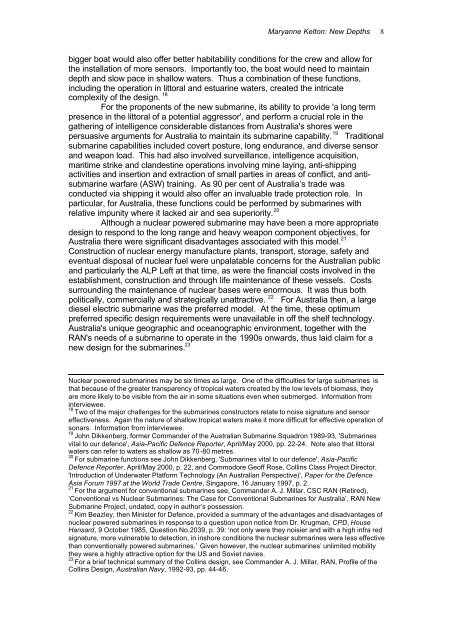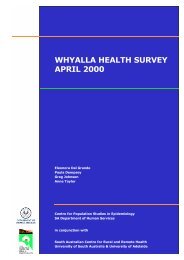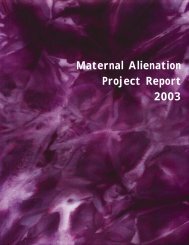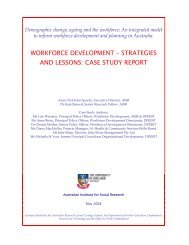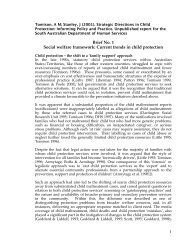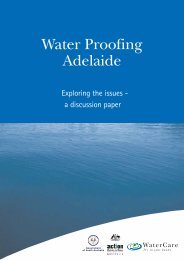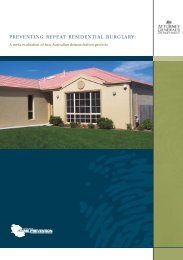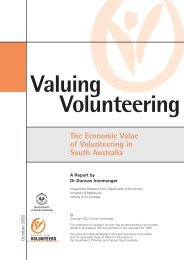New Depths in Australia-US Relations: The Collins Class ...
New Depths in Australia-US Relations: The Collins Class ...
New Depths in Australia-US Relations: The Collins Class ...
Create successful ePaper yourself
Turn your PDF publications into a flip-book with our unique Google optimized e-Paper software.
Maryanne Kelton: <strong>New</strong> <strong>Depths</strong> 8bigger boat would also offer better habitability conditions for the crew and allow forthe <strong>in</strong>stallation of more sensors. Importantly too, the boat would need to ma<strong>in</strong>ta<strong>in</strong>depth and slow pace <strong>in</strong> shallow waters. Thus a comb<strong>in</strong>ation of these functions,<strong>in</strong>clud<strong>in</strong>g the operation <strong>in</strong> littoral and estuar<strong>in</strong>e waters, created the <strong>in</strong>tricatecomplexity of the design. 18For the proponents of the new submar<strong>in</strong>e, its ability to provide 'a long termpresence <strong>in</strong> the littoral of a potential aggressor', and perform a crucial role <strong>in</strong> thegather<strong>in</strong>g of <strong>in</strong>telligence considerable distances from <strong>Australia</strong>'s shores werepersuasive arguments for <strong>Australia</strong> to ma<strong>in</strong>ta<strong>in</strong> its submar<strong>in</strong>e capability. 19 Traditionalsubmar<strong>in</strong>e capabilities <strong>in</strong>cluded covert posture, long endurance, and diverse sensorand weapon load. This had also <strong>in</strong>volved surveillance, <strong>in</strong>telligence acquisition,maritime strike and clandest<strong>in</strong>e operations <strong>in</strong>volv<strong>in</strong>g m<strong>in</strong>e lay<strong>in</strong>g, anti-shipp<strong>in</strong>gactivities and <strong>in</strong>sertion and extraction of small parties <strong>in</strong> areas of conflict, and antisubmar<strong>in</strong>ewarfare (ASW) tra<strong>in</strong><strong>in</strong>g. As 90 per cent of <strong>Australia</strong>’s trade wasconducted via shipp<strong>in</strong>g it would also offer an <strong>in</strong>valuable trade protection role. Inparticular, for <strong>Australia</strong>, these functions could be performed by submar<strong>in</strong>es withrelative impunity where it lacked air and sea superiority. 20Although a nuclear powered submar<strong>in</strong>e may have been a more appropriatedesign to respond to the long range and heavy weapon component objectives, for<strong>Australia</strong> there were significant disadvantages associated with this model. 21Construction of nuclear energy manufacture plants, transport, storage, safety andeventual disposal of nuclear fuel were unpalatable concerns for the <strong>Australia</strong>n publicand particularly the ALP Left at that time, as were the f<strong>in</strong>ancial costs <strong>in</strong>volved <strong>in</strong> theestablishment, construction and through life ma<strong>in</strong>tenance of these vessels. Costssurround<strong>in</strong>g the ma<strong>in</strong>tenance of nuclear bases were enormous. It was thus bothpolitically, commercially and strategically unattractive. 22 For <strong>Australia</strong> then, a largediesel electric submar<strong>in</strong>e was the preferred model. At the time, these optimumpreferred specific design requirements were unavailable <strong>in</strong> off the shelf technology.<strong>Australia</strong>'s unique geographic and oceanographic environment, together with theRAN's needs of a submar<strong>in</strong>e to operate <strong>in</strong> the 1990s onwards, thus laid claim for anew design for the submar<strong>in</strong>es. 23Nuclear powered submar<strong>in</strong>es may be six times as large. One of the difficulties for large submar<strong>in</strong>es isthat because of the greater transparency of tropical waters created by the low levels of biomass, theyare more likely to be visible from the air <strong>in</strong> some situations even when submerged. Information from<strong>in</strong>terviewee.18 Two of the major challenges for the submar<strong>in</strong>es constructors relate to noise signature and sensoreffectiveness. Aga<strong>in</strong> the nature of shallow tropical waters make it more difficult for effective operation ofsonars. Information from <strong>in</strong>terviewee.19 John Dikkenberg, former Commander of the <strong>Australia</strong>n Submar<strong>in</strong>e Squadron 1989-93, 'Submar<strong>in</strong>esvital to our defence', Asia-Pacific Defence Reporter, April/May 2000, pp. 22-24. Note also that littoralwaters can refer to waters as shallow as 70-80 metres.20 For submar<strong>in</strong>e functions see John Dikkenberg, 'Submar<strong>in</strong>es vital to our defence', Asia-PacificDefence Reporter, April/May 2000, p. 22, and Commodore Geoff Rose, Coll<strong>in</strong>s <strong>Class</strong> Project Director,'Introduction of Underwater Platform Technology (An <strong>Australia</strong>n Perspective)', Paper for the DefenceAsia Forum 1997 at the World Trade Centre, S<strong>in</strong>gapore, 16 January 1997, p. 2.21 For the argument for conventional submar<strong>in</strong>es see, Commander A. J. Millar, CSC RAN (Retired),‘Conventional vs Nuclear Submar<strong>in</strong>es: <strong>The</strong> Case for Conventional Submar<strong>in</strong>es for <strong>Australia</strong>’, RAN <strong>New</strong>Submar<strong>in</strong>e Project, undated, copy <strong>in</strong> author’s possession.22 Kim Beazley, then M<strong>in</strong>ister for Defence, provided a summary of the advantages and disadvantages ofnuclear powered submar<strong>in</strong>es <strong>in</strong> response to a question upon notice from Dr. Krugman, CPD, HouseHansard, 9 October 1985, Question No.2039, p. 39: ‘not only were they noisier and with a high <strong>in</strong>fra redsignature, more vulnerable to detection, <strong>in</strong> <strong>in</strong>shore conditions the nuclear submar<strong>in</strong>es were less effectivethan conventionally powered submar<strong>in</strong>es.’ Given however, the nuclear submar<strong>in</strong>es’ unlimited mobilitythey were a highly attractive option for the <strong>US</strong> and Soviet navies.23 For a brief technical summary of the Coll<strong>in</strong>s design, see Commander A. J. Millar, RAN, Profile of theColl<strong>in</strong>s Design, <strong>Australia</strong>n Navy, 1992-93, pp. 44-46.


